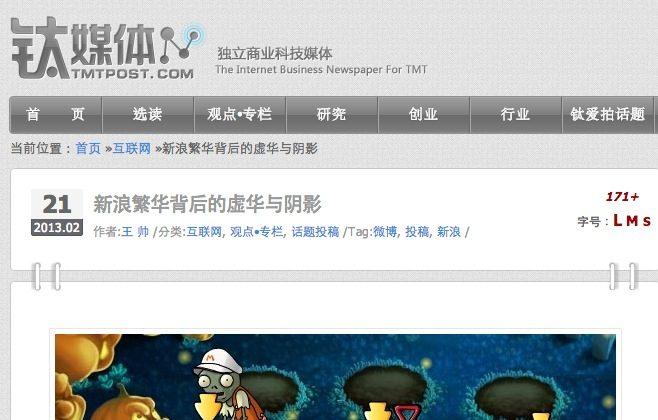Chinese online media company Sina says it has 500 million people—about a third of China’s population—on its Twitter-like platform called Weibo. But a recent report suggests the numbers include many fraudulent “zombie” accounts, meant to pad the books.
A report titled “The Illusion and Shadow Behind Sina’s Flourishing Numbers,” was published at TMT Post, a Chinese online media that focuses on market research in online technology. Its author Wang Shuai works for CCID Consulting Company Limited. The report was later deleted from the website.
Of Sina’s 500 million registered Weibo users, the number of active daily users was 46.3 million—a 74 percent increase compared with the same period last year—according to data recently released by the company.
100 Million Zombies
According to Wang Shuai’s article, Sina has adopted many “secret methods” for attempting to make its business profitable, most notably by creating fake users whose accounts can follow, comment, and vote.
“Sina’s technical staff have developed an internal Weibo platform with over 100 million ‘users,’ and the number is still increasing on a massive scale. However, those so-called users are all ‘dead;’ some of them are zombie followers, and some are still breathing.”
The term “zombie” refers to accounts with profile pictures that follow other accounts, but have no followers and do not post comments; while those who are “still breathing” actually post comments.
It’s all computer-generated though, Wang writes. They follow each other, and comment and vote on each others’ content. Sina then attempts to sell advertising space based on the numbers created by all this fake activity, Wang alleges.
Alongside this is an industry in selling fake Weibo followers. Wang cites some 2013 prices: $0.80 per thousand zombie followers, $4.50 per thousand super followers (with less than 100 followers each), $5.60 per thousand premium followers (with hundreds of followers and over 100 posts), and $16 per thousand customized followers.
Buyers can also determine the activities of their zombie hordes.
Sina’s Business
Between Feb. 11 and 17, Sina had the highest number of visitors of the five Chinese Weibo (or “microblog”) platforms–Sina, QQ Tencent, Sohu, NetEase, and Digu–as shown by data from the China Internet Information Centre (CNNIC). Specifically, Sina accounted for 63.5 percent of the total Weibo traffic, had the highest number of page views with 80.6 percent, and the longest user time at 81.2 percent during this period.
Although Sina is proud to be number one and has invested heavily in its Weibo platform, it has not enjoyed matching returns.
In its recent 2012 financial report, Sina achieved a net revenue of US$139 million, netting a profit of US$2.4 million, which is a 74.3 percent drop from 2011.
The TMT Post article attributes this loss to the large investment Sina pumped into staffing, office space, and sales costs for its Weibo business. However, the financial report shows that Sina’s daily active user figure is less than 10 percent of its claimed total registered users.
Herman Yu, Sina’s chief financial officer, said that the company lost US$93 million due to its Weibo business, mainland media Netease reported on Feb. 20.
Research by Ariel Tian. Translation by Amy Lien and Gao Hao. Written in English by Cassie Ryan.
Read Original Chinese article.
The Epoch Times publishes in 35 countries and in 21 languages. Subscribe to our e-newsletter.






